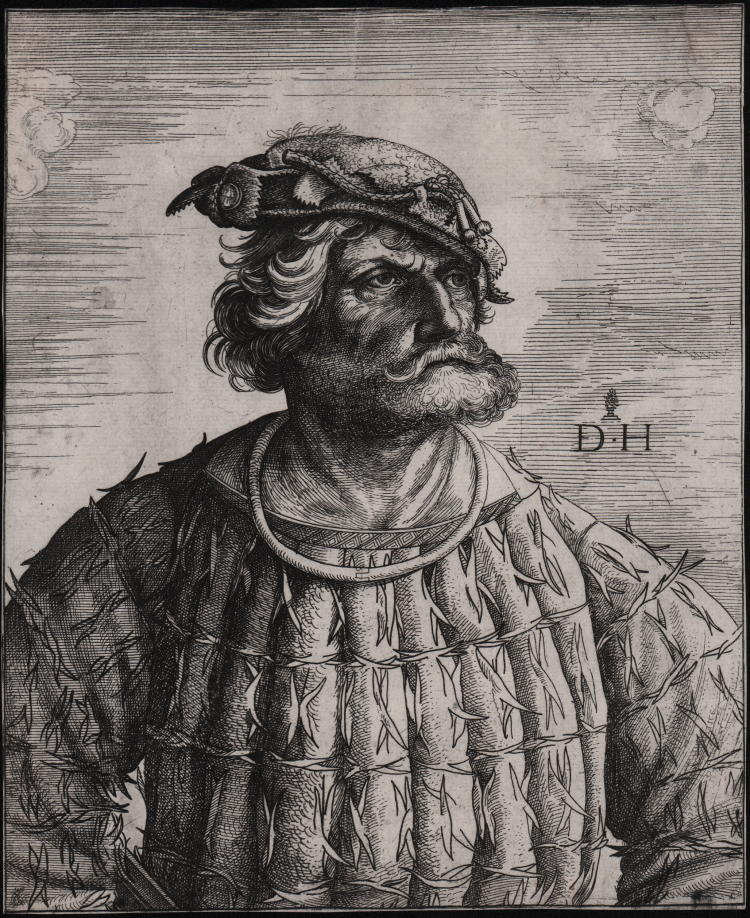



| Reference: | S41937 |
| Author | Anonimo |
| Year: | 1550 ca. |
| Measures: | 172 x 210 mm |


| Reference: | S41937 |
| Author | Anonimo |
| Year: | 1550 ca. |
| Measures: | 172 x 210 mm |
Etching, signed with Daniel Hopfer's monogram at centre right. Reverse copy after Hopfer (Hollstein 97).
Magnificent proof, printed on contemporary laid paper, trimmed close the platemark, in very good condition.
Portrait of Kuntz (Conrad) von der Rosen, jester at the court of Maximilian I half-length, turned slightly to right, the head in three-quarter profile.
Although there is no inscription to identify Hopfer's sitter, Panofsky in his enlightening article (Conrad Celtes and Kunz von der Rosen: Two Problems in Portrait Identification) on this print brought together overwhelming evidence from sixteenth-century pictorial sources that the figure represents the Emperor Maximilian's remarkable court jester, Kuntz von der Rosen. The sources include drawings by Hans Holbein the Elder in the Kupferstichkabinett, Berlin, a woodcut by Hans Burgkmair in his 'Triumph of Maximilian' and an inscribed miniature copy after this etching in a historical work by Johann Jacob Fugger of 1555. He is also seen in the foreground of a large watercolour by Narziss Renner of Augsburg families at a dance, dated 1522, based in part on an etching by Altdorfer (formerly Berlin, Kupferstichkabinett; see E,7.183). The son of an innkeeper from Hopfer's home town of Kaufbeuren, Kuntz joined Maximilian on his expedition to Burgundy in 1478. He so distinguished himself by his courage, loyalty and uncommon wit, that he became, as Panofsky described it: "an unparalleled combination of personal companion, bodyguard, confidant, adviser and court-jester" to the Emperor (op. cit., p. 47). Kuntz was knighted and acquired Augsburg citizenship by marriage in 1506; he died in 1519 shortly after the death of Maximilian.
Hopfer produced a small number of portrait prints of leading figures of the day which included various Popes, King Francis I of France and the emperors Maximilian and Charles V, as well as Martin Luther and Erasmus. They are all etched with a particular attention to detail and must have been produced for public distribution; they are also all in profile, with the exception of Kuntz von der Rosen, who is represented in a striking frontal position. Hopfer frequently derived his compositions from other sources, and it is possible that this was made after a portrait painting by Hans Burgkmair. A related painting of the same sitter in the same direction as Hopfer's print (Brockelsby, Lord Yarborough collection) was reproduced by Richter with an attribution to Burgkmair, but is thought to be a pastiche attributed to the Venetian painter Pietro della Vecchia (1605-78). The popular impact of Hopfer's print was in any case considerable.
An Italian engraved copy, in reverse, was issued as a portrait of Gonsalvo de Cordova, the Spanish captain-general, after his death in 1515 (Hind, I, p. 255, 14); this in its turn, was copied in another Italian engraving with the same misleading identification (see J. Levenson et al., 'Early Italian Engravings from the National Gallery of Art, Washington', exh. cat., Washington, National Gallery of Art, 1973, 191).
|
Hollstein, XV, n. 97; Panofsky, in Art Bullettin 24, n.1, 1942, 39-53; 199-201); TIB. 17, 163.
|
Anonimo
|
Hollstein, XV, n. 97; Panofsky, in Art Bullettin 24, n.1, 1942, 39-53; 199-201); TIB. 17, 163.
|
Anonimo